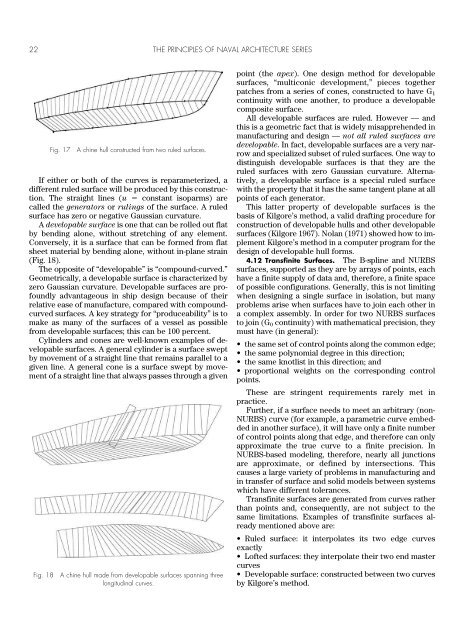The Geometry of Ships
Create successful ePaper yourself
Turn your PDF publications into a flip-book with our unique Google optimized e-Paper software.
22 THE PRINCIPLES OF NAVAL ARCHITECTURE SERIES<br />
If either or both <strong>of</strong> the curves is reparameterized, a<br />
different ruled surface will be produced by this construction.<br />
<strong>The</strong> straight lines (u constant isoparms) are<br />
called the generators or rulings <strong>of</strong> the surface. A ruled<br />
surface has zero or negative Gaussian curvature.<br />
A developable surface is one that can be rolled out flat<br />
by bending alone, without stretching <strong>of</strong> any element.<br />
Conversely, it is a surface that can be formed from flat<br />
sheet material by bending alone, without in-plane strain<br />
(Fig. 18).<br />
<strong>The</strong> opposite <strong>of</strong> “developable” is “compound-curved.”<br />
Geometrically, a developable surface is characterized by<br />
zero Gaussian curvature. Developable surfaces are pr<strong>of</strong>oundly<br />
advantageous in ship design because <strong>of</strong> their<br />
relative ease <strong>of</strong> manufacture, compared with compoundcurved<br />
surfaces. A key strategy for “produceability” is to<br />
make as many <strong>of</strong> the surfaces <strong>of</strong> a vessel as possible<br />
from developable surfaces; this can be 100 percent.<br />
Cylinders and cones are well-known examples <strong>of</strong> developable<br />
surfaces. A general cylinder is a surface swept<br />
by movement <strong>of</strong> a straight line that remains parallel to a<br />
given line. A general cone is a surface swept by movement<br />
<strong>of</strong> a straight line that always passes through a given<br />
Fig. 18<br />
Fig. 17<br />
A chine hull constructed from two ruled surfaces.<br />
A chine hull made from developable surfaces spanning three<br />
longitudinal curves.<br />
point (the apex). One design method for developable<br />
surfaces, “multiconic development,” pieces together<br />
patches from a series <strong>of</strong> cones, constructed to have G 1<br />
continuity with one another, to produce a developable<br />
composite surface.<br />
All developable surfaces are ruled. However — and<br />
this is a geometric fact that is widely misapprehended in<br />
manufacturing and design — not all ruled surfaces are<br />
developable. In fact, developable surfaces are a very narrow<br />
and specialized subset <strong>of</strong> ruled surfaces. One way to<br />
distinguish developable surfaces is that they are the<br />
ruled surfaces with zero Gaussian curvature. Alternatively,<br />
a developable surface is a special ruled surface<br />
with the property that it has the same tangent plane at all<br />
points <strong>of</strong> each generator.<br />
This latter property <strong>of</strong> developable surfaces is the<br />
basis <strong>of</strong> Kilgore’s method, a valid drafting procedure for<br />
construction <strong>of</strong> developable hulls and other developable<br />
surfaces (Kilgore 1967). Nolan (1971) showed how to implement<br />
Kilgore’s method in a computer program for the<br />
design <strong>of</strong> developable hull forms.<br />
4.12 Transfinite Surfaces. <strong>The</strong> B-spline and NURBS<br />
surfaces, supported as they are by arrays <strong>of</strong> points, each<br />
have a finite supply <strong>of</strong> data and, therefore, a finite space<br />
<strong>of</strong> possible configurations. Generally, this is not limiting<br />
when designing a single surface in isolation, but many<br />
problems arise when surfaces have to join each other in<br />
a complex assembly. In order for two NURBS surfaces<br />
to join (G 0 continuity) with mathematical precision, they<br />
must have (in general):<br />
• the same set <strong>of</strong> control points along the common edge;<br />
• the same polynomial degree in this direction;<br />
• the same knotlist in this direction; and<br />
• proportional weights on the corresponding control<br />
points.<br />
<strong>The</strong>se are stringent requirements rarely met in<br />
practice.<br />
Further, if a surface needs to meet an arbitrary (non-<br />
NURBS) curve (for example, a parametric curve embedded<br />
in another surface), it will have only a finite number<br />
<strong>of</strong> control points along that edge, and therefore can only<br />
approximate the true curve to a finite precision. In<br />
NURBS-based modeling, therefore, nearly all junctions<br />
are approximate, or defined by intersections. This<br />
causes a large variety <strong>of</strong> problems in manufacturing and<br />
in transfer <strong>of</strong> surface and solid models between systems<br />
which have different tolerances.<br />
Transfinite surfaces are generated from curves rather<br />
than points and, consequently, are not subject to the<br />
same limitations. Examples <strong>of</strong> transfinite surfaces already<br />
mentioned above are:<br />
• Ruled surface: it interpolates its two edge curves<br />
exactly<br />
• L<strong>of</strong>ted surfaces: they interpolate their two end master<br />
curves<br />
• Developable surface: constructed between two curves<br />
by Kilgore’s method.



